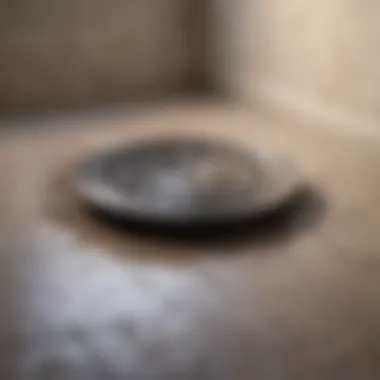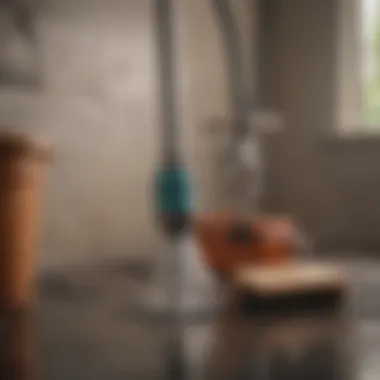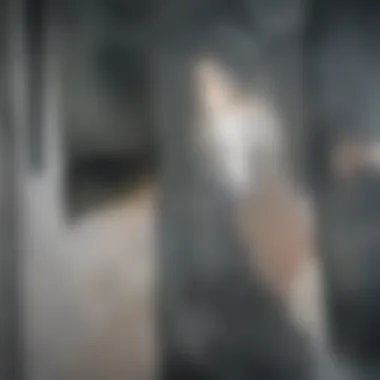Understanding and Resolving Slow Shower Drains


Intro
Slow shower drains are an often overlooked yet critical issue in household maintenance. They can lead to annoying water pooling, ineffective use of the shower space, and even more serious plumbing problems over time. Understanding what causes these slow drains is essential for any homeowner or renter aiming for a seamless shower experience.
Issues with shower drains may not just stem from immediate concerns; they are often symptoms of underlying problems. Recognizing this can help in preventing future occurrences. The need for proactive maintenance becomes clear when considering the water's role in daily hygiene practices and comfort. This article will delve into the myriad factors contributing to slow drains, preventive techniques, and reliable remedies to restore optimal drainage.
Beyond mere inconvenience, a slow shower drain can pose significant risks to the plumbing system. Water that doesn’t drain properly can lead to backflow, which exposes your home to mold and mildew. These growths can impact health, leading to respiratory problems and other concerns. Therefore, a comprehensive understanding of this topic is vital for maintaining a healthy living environment.
By the end of this guide, readers will be equipped with the knowledge of both minor DIY fixes and when to engage professionals for assistance. The aim is to foster a proactive approach to plumbing issues, ensuring that every shower remains a refreshing and satisfying experience.
Prelude to Slow Shower Drains
Slow shower drains are a common problem faced by many homeowners, yet they often go overlooked until they become a significant issue. It is essential to address this topic since understanding the causes and effects of slow drainage can lead to better maintenance and prevention strategies for long-term home care. An often neglected aspect of plumbing, slow shower drains can greatly impact the overall comfort and hygiene of daily routines.
In this article, we will explore the complexities surrounding slow shower drains, beginning with an analysis of the underlying issues that contribute to poor drainage. By highlighting key factors such as accumulation of debris and structural pipe issues, we aim to provide a well-rounded understanding of why these problems occur and how they can be effectively managed.
Understanding the Problem
The problem of slow shower drains generally arises from several culprits — including hair, soap scum, and mineral buildup stemming from hard water. Such factors can lead to a gradual decrease in flow rate, making showers less enjoyable and potentially damaging plumbing systems over time. Understanding these elements is crucial, as they directly affect both functionality and the aesthetic appeal of a bathroom. By gaining an insight into what causes drains to slow down, homeowners can take proactive steps to mitigate these problems before they escalate.
Importance of Addressing Drain Issues
Addressing drain issues promptly is vital for several reasons. First, unresolved slow drains can lead to more severe plumbing problems, such as full blockages, which can incur hefty repair costs. Additionally, standing water in showers can create unpleasant odors, which may permeate the bathroom environment. Left unchecked, these odors can be detrimental to the overall ambiance of the home.
Moreover, maintaining clear shower drains plays a significant role in promoting hygiene. Accumulation of water can foster bacterial growth and other unpleasant situations. Investing time and effort into managing slow drains can save homeowners significant time and expenses in the long run, establishing a smoother, more enjoyable home experience.
Understanding and resolving slow shower drain issues are crucial for maintaining a healthy and functional home environment.
By taking a comprehensive approach towards drain maintenance and problem resolution, homeowners can ensure a better quality of life and enhance the longevity of their plumbing systems.
Causes of Slow Shower Drainage
Understanding the causes of slow shower drainage is crucial for effective problem-solving. This section will explore various factors that lead to poor drainage, each with unique characteristics and implications. A comprehensive knowledge of these causes ensures homeowners can implement appropriate solutions or take preventive measures early on. Recognizing these issues can save both time and money, as minor problems can escalate into more significant and costly repairs if ignored.
Accumulation of Hair and Debris
Accumulation of hair is one of the most frequent causes of slow shower drains. Showers often collect loose strands, which, when mixed with soap and other residues, can create substantial clogs. Over time, hair binds with other materials, forming a solid mass that restricts water flow.
A simple method for addressing this issue is to regularly remove the drain cover and clean out any visible hair. Also, using a drain strainer can help catch hair before it enters the pipes. Failures to address hair accumulation can lead to persistent clogging and may even require professional intervention down the line.
Mineral Buildup from Hard Water
Hard water, prevalent in many regions, carries high concentrations of minerals such as calcium and magnesium. When this water flows through your plumbing system, it can leave behind mineral deposits in the pipes. These deposits gradually build up, narrowing the pipe's interior and hampering water flow. This condition is known as limescale build-up.
To combat this, using a water softener can significantly reduce mineral accumulation. Cleaning with specialized solutions that dissolve lime deposits can also be effective. Homeowners should consider testing their water quality to determine if mineral buildup is contributing to drainage issues.
Structural Issues with Pipes
Sometimes, slow drainage relates directly to the condition and structure of the pipes themselves. Problems may arise from outdated materials, improper installation, or damage over time. For instance, older pipes might lose their integrity due to corrosion, leading to leaks or blockages within the system.


Homeowners should consider getting a plumbing inspection if they suspect structural issues. Monitoring for signs of sagging or uneven pipes can also be beneficial. Addressing these underlying problems is essential to maintain optimal drainage performance and prevent more severe plumbing complications.
Clogs Formed by Soap Scum
Soap scum is another common contributor to slow shower drains. As soap and shampoo mix with water, they can leave behind a greasy residue. This buildup sticks to the sides of the pipes, gradually creating blockages. The residue is typically worse when using bar soap, which tends to leave more soap scum compared to liquid alternatives.
Regular cleaning and opting for liquid soaps can help minimize scum accumulation. Additionally, a mixture of vinegar and baking soda offers a natural way to break down soap scum and keep pipes clear. Regular maintenance is vital to prevent soap-related clogs from escalating.
Tree Root Intrusion in External Pipes
In some cases, the slow drainage can be linked to tree roots invading external pipes. Shrubs and trees naturally seek out water sources, and if they detect moisture from cracked pipes, they may send roots to penetrate these openings. This intrusion can create significant blockages that obstruct the flow of water.
To identify this issue, homeowners might notice unusual drainage patterns or frequent backups. A professional plumber can perform inspections using specialized cameras to assess root intrusion. If detected, removal is typically necessary, and preventive planting strategies can help avoid similar issues in the future.
Signs of a Slow Shower Drain
Recognizing the signs of a slow shower drain is crucial in maintaining the overall health of your plumbing system. Ignoring these early indicators can lead to more severe issues, possibly resulting in costly repairs. Understanding these signs not only enhances your awareness but enables timely intervention. This section will delve into three main symptoms that often signify a slow shower drain and their implications for your home.
Pooling Water During Showers
One of the most immediate and noticeable signs of a slow shower drain is water pooling around your feet while showering. This situation arises when the drainage system cannot keep up with the flow of water exiting the showerhead. It indicates a potential blockage somewhere in the drain system.
Accumulation of stagnant water is not just unpleasant; it can also create an environment conducive to mold growth and unpleasant odors. Proper drainage ensures that water is directed away efficiently. If this pooling becomes more frequent, it’s important to address it promptly.
Unpleasant Odors from the Drain
Another signal of a potential drainage issue is the presence of unpleasant odors emanating from the drain. Foul smells often suggest that organic materials are breaking down within the pipes or that standing water is turning stagnant. This is not just a nuisance; it can lead to health risks associated with mold or bacteria proliferation.
Addressing the problem early is vital. Consistent odors could indicate a significant clog or buildup that needs immediate attention. Regular inspections or simple cleaning methods can help prevent this from becoming a chronic issue.
Gurgling Sounds from the Drain
Gurgling sounds occurring when water is draining can also indicate a malfunction in the drainage system. This noise often happens due to air being trapped and released within the pipes. It can suggest that the air and water are struggling to move through clogs or blockages. While this may seem like a minor annoyance, it can be a precursor to more serious drainage problems.
If gurgling sounds are regular and persistent, it is essential to investigate the issue further. Ignoring these sounds could lead not only to slow drainage but also to more complex plumbing problems down the line.
Addressing the signs of a slow shower drain early can save homeowners from larger plumbing issues, reduce repair costs, and maintain a healthy home environment.
Ultimately, these signs serve as important indicators that should not be ignored. Quick actions can lead to effective solutions, keeping your drains functional and your showers enjoyable.
Preventive Measures for Drain Maintenance
Preventive measures for drain maintenance are vital in ensuring a functional and efficient drainage system in your home. Slow shower drains can often lead to significant inconvenience if not addressed early. By taking proactive steps, homeowners can reduce the likelihood of clogs and potential flooding. Key elements of preventive maintenance include regular cleaning, effective use of drain covers, and routine inspections. These practices can extend the life of your plumbing while also minimizing emergency repairs and costs associated with persistent drainage issues.
Regular Cleaning of Drain Screens
Regular cleaning of drain screens is an essential practice for maintaining clear shower drains. These screens act as the first line of defense against hair and debris. Without sufficient cleaning, hair can build up, resulting in slower water drainage. To effectively clean the screens, it is recommended to remove them from the drain and rinse under warm water regularly. This simple step can significantly reduce the frequency of clogged drains and maintain an optimal flow rate.
Using Drain Covers Effectively


Using drain covers can be an efficient method to prevent debris from entering the drain system. Selecting the right drain cover helps in capturing hair and soap scum before they can accumulate within pipes. It is important to ensure these covers fit securely over the shower drain and are easy to remove for cleaning. A well-fitted drain cover can drastically reduce the frequency of clogs, providing an easy solution while also enhancing the overall appearance of your bathroom.
Implementing Routine Drain Inspections
Implementing routine drain inspections can identify potential issues before they escalate into serious problems. Homeowners should inspect the drains for any early signs of blockage, such as slow drainage or unusual odors. Conducting these inspections at least once every few months can highlight concerns such as mineral buildup or structural pipe issues. Early detection not only saves time but can also be cost-effective, preventing the need for more extensive repairs down the line.
Regular preventive measures can prolong your plumbing system's lifespan and maintain its efficiency.
DIY Solutions for Slow Shower Drains
Addressing slow shower drains can be a challenge. Yet, utilizing DIY solutions offers practical benefits. Many homeowners prefer to handle these issues themselves. Not only can this save money, but it allows for quicker resolution of minor problems.
Moreover, engaging in DIY activities fosters a sense of accomplishment, as well as immediate control over home maintenance. However, it is essential to understand that not all situations warrant a DIY approach. Knowing the right time to call in professional help is crucial.
Using a Plunger
The plunger remains one of the simplest tools in any homeowner's toolkit. It works effectively for minor clogs. Begin by filling the shower with a few inches of water to create suction. Position the plunger over the drain, ensuring a good seal. Push down with a firm force, then pull up sharply. Repeat several times.
This method may dislodge hair and debris that have created blockages. Just remember, plunging should only be employed when water pooling is evident.
Employing DIY Drain Cleaners
Another popular option is the use of DIY drain cleaners. Common household items, such as baking soda and vinegar, can provide effective results. To use this method, pour half a cup of baking soda down the drain, followed by half a cup of vinegar. This combination creates a chemical reaction. Wait for about 30 minutes before flushing the drain with hot water.
While this approach is generally safe, it's vital to avoid mixing different chemical cleaners. The results could be hazardous. Moreover, regular use of this method can help maintain clear drains over time.
Removing Hair Clogs Manually
Sometimes, the best approach is to remove clogs manually. This method requires a bit of hands-on effort. First, gather your materials. You will need a pair of gloves and a long, flexible tool. A wire hanger can serve this purpose.
Begin by removing the drain cover. Then, use the wire hanger to fish out any visible hair or debris. Once you've removed the clogs, clean the area thoroughly before replacing the drain cover. Taking these actions can assist in preventing future clogs.
Remember, tackling slow shower drains at the first sign of trouble can save significant time and resources.
Implementing these DIY solutions can greatly improve your shower's performance. It is handy to be informed and prepared. Monitoring your drainage regularly can prevent issues from escalating.
Professional Solutions for Persistent Issues
Addressing slow shower drains often requires a balanced approach. While many homeowners can handle basic maintenance and DIY solutions, some drainage issues demand professional expertise. Understanding when to seek outside help is essential. Clear benefits lie in accessing advanced techniques and specialized tools that can efficiently resolve more complex problems.
When to Call a Plumber
Determining the right moment to call a plumber can save time and potentially avoid further damage. Here are some indicators:
- Persistent Clogs: If repeat efforts to unclog the drain fail, it may indicate a deeper issue, such as blockages in the main line.
- Slow Drainage: Noticeable slow drainage that does not improve with routine cleaning may suggest pipe deterioration or structural problems.
- Unusual Sounds: Gurgling noises from the drain can signal issues in the plumbing system, indicating that professional inspection is warranted.
- Leaks or Water Damage: Any sign of leaks or water accumulation around the shower area can be a red flag for serious plumbing concerns.
Types of Professional Drain Cleaners
Professional drain cleaning typically involves several methods that are more effective than ordinary store-bought solutions. Common techniques include:


- Hydro Jetting: This method uses high-pressure water jets to remove clogs and debris, effectively cleaning the entire pipe.
- Snares & Augers: These tools can reach blockages that may be deep within the plumbing. They are effective in removing hair, roots, and other hard materials.
- Chemical Drain Cleaners: Some professionals may employ strong chemicals designed to dissolve tough clogs, although this method should be used cautiously due to potential damage to pipes.
Cost Considerations for Professional Help
The cost of hiring a plumber can vary widely based on several factors. It is crucial to understand potential expenses:
- Service Fees: These can range significantly based on location and the plumber's experience.
- Scope of Work: Complex jobs requiring specialized equipment may incur higher costs.
- Follow-Up Services: Some plumbers might suggest maintenance plans to prevent future issues, which can be beneficial but add to the overall expense.
Invest in a good quality inspection before making major repairs. Understanding what needs fixing can save money in the long run.
Long-Term Considerations for Drain Health
Maintaining drain health is essential for the long-term enjoyment of a functional and efficient shower. Slow drains can cause water pooling, which leads to mold and unpleasant odors. It is important to think not only about immediate fixes but also about how to ensure that drains remain in good health over time. This proactive approach can save time and money down the line, preventing more costly repairs or replacements.
Investing in Pipe Upgrades
One of the most impactful strategies for improving drain performance is upgrading old pipe systems. Older pipes, especially those made of materials like galvanized steel or lead, can corrode and clog over time, leading to slow drainage. Investing in modern materials such as PVC or PEX can enhance flow efficiency. These materials resist corrosion and are less likely to accumulate build-up.
Additionally, if house renovations are planned, reconsider the layout of existing plumbing. The need for multiple bends and turns can slow water flow. Opting for a more direct route for drainage can significantly improve performance.
Understanding Different Pipe Materials
Different pipe materials have varying thermal and physical properties, which can directly affect drainage effectiveness. Besides PVC and PEX, you may encounter copper, cast iron, and ABS.
- PVC: Lightweight, resistant to corrosion, and easy to install, making it a popular choice for residential plumbing.
- PEX: Flexible and durable, making it perfect for retrofitting and repairs.
- Copper: Known for longevity and antimicrobial properties but can be expensive and is prone to corrosion in certain water conditions.
- Cast Iron: Provides sound insulation, but is heavier and may rust over time.
Each material has its advantages and potential drawbacks. It is crucial to assess local water quality and plumbing needs before making a decision.
Adopting Sustainable Practices for Water Use
Fostering a culture of sustainability is beneficial not just for the environment, but also for the longevity of your plumbing systems.
Simple practices can enhance drain health:
- Using Water-Saving Showerheads: These reduce water flow but maintain pressure, helping to prevent clogs.
- Be Mindful of What Goes Down the Drain: Avoid pouring grease or food waste into the shower.
- Regular Maintenance: Periodically check for signs of slow drainage and address issues promptly.
Incorporating sustainable practices can contribute significantly to the overall health of your plumbing system while also promoting an eco-friendly lifestyle.
Regular consideration of long-term drainage health ultimately leads to a better and more efficient home environment.
Culmination
In the quest for maintaining an efficient and functional home, addressing slow shower drains is often overlooked. However, this article clearly illustrates that understanding and resolving drain issues is not just a matter of convenience; it is essential for ensuring overall plumbing health. Slow drains can lead to more significant plumbing problems, contributing to water damage and unpleasant odors that permeate the living space. Therefore, the significance of this topic is profound.
Recap of Key Points
- Understanding Causes: Slow shower drains may be caused by various factors, including hair accumulation, mineral buildup from hard water, and structural pipe issues. Every homeowner must recognize these signs to prevent exacerbating the problem.
- Preventive Measures: Simple and routine maintenance can play a significant role in prolonging the efficiency of your drains. Techniques such as regular cleaning of drain screens and employing drain covers are effective methods.
- DIY Solutions: Homeowners can apply practical DIY solutions. With proper use of plungers, homemade drain cleaners, and manual hair removal, they can often resolve minor issues independently.
- Professional Help: Knowing when to seek professional assistance is crucial. Persistent problems may require the expertise of a plumber equipped with specialized tools and knowledge to diagnose and fix complicated blockages.
- Long-Term Strategies: Investing in high-quality pipe materials and sustainable practices can save costs and reduce future drainage issues.
Final Thoughts on Drain Maintenance
Regular drain maintenance is a crucial aspect of home care that should not be neglected. Establishing a consistent cleaning routine and employing preventive strategies will help in avoiding the nuisance of slow drains. These simple actions can ensure a more pleasant and functional shower experience. Over time, they contribute to the longevity of plumbing systems, safeguarding investments made in your property. While minor issues may be manageable, understanding when to consult professionals emphasizes the need for timely action.
"Invest in maintenance to prevent costly repairs in the future."
Cultivating awareness around drain health is not only practical but also enhances the overall living experience in your home.







